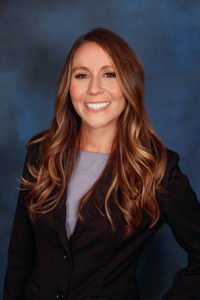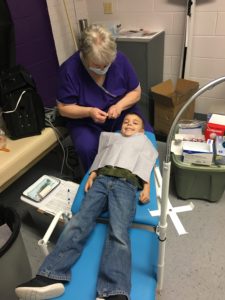 By Dr. Carol Morrow, CDA President-Elect
By Dr. Carol Morrow, CDA President-Elect
From the Spring 2017 Journal of the Colorado Dental Association
When you’re a rural dentist, there is one thing you don’t have to worry about: being busy. While I know this is something that would be coveted in urban areas, it does pose an entirely new set of problems. The biggest one being, how am I going to treat all these people?
When I came to practice with my dad in the little town of Walsh in southeast Colorado 11 years ago, I didn’t fully understand how crazy it was to have two dentists in a town of 700 people. It seemed like a ridiculous situation, because how on Earth could a small town like this support two dentists? I quickly came to realize that we were the only full-time dentists in a 70-mile radius, which equated to almost 10,000 people. Now, you can estimate that half of those individuals will only ever see a dentist in an emergency, which leaves roughly 5,000 patients for two dentists. Then when one of those dentists retires, that leaves a lot of patients for one dentist.

Cindy Packard, R.D.H., provides a prophy and fl2 treatment to a very happy patient.
I am from a county that has a higher than average percentage of Medicaid patients, so when the adult Medicaid dental benefit came into effect in July of 2015, this meant a couple thousand patients now had coverage that they never had in the past to receive dental care. This posed a new problem that needed an immediate solution.
The day I began practicing, I made it my personal mission to treat every patient who came into my office the same. This means that any given day I have no idea who is a patient under Medicaid, private insurance, or private pay before I see them. I quickly learned that I didn’t have enough hours in the day to see everyone so I needed to look at alternative ways to provide care.
This past February, my staff and I went to all of the schools in our county to provide dental exams and prophies. There are five schools in Baca County, so we blocked out a full week of office time and went to each school, driving about 200 miles roundtrip. In the smaller schools, we attempted to see the entire elementary population, and in the larger schools, our goal was to see the kindergarten and sixth grade classes. The schools sent home consent forms to all the student’s families ahead of time so we could gather consent and insurance information prior to the visit. Once at the school, we set up three stations. The first station was for radiographs and intraoral photos. The second was a prophy and fl2 varnish by the hygienist, where she also noted any clinical areas of concern that I should review later during our evaluations of the patient records. The third and final station, was oral hygiene instruction and tobacco education. The use of smokeless tobacco is rampant in our area, beginning as young as age 10.

The oral hygiene and tobacco education station is a vital part of this dental program. Back row: Ofelia Romo (left), Eva Fehr and Cindy Packard, R.D.H. Front row: Samantha Thomas (left) with the Southeast Colorado Hospital, and Erika Ragland.
Each school provided a liaison to check consent forms and bring kids to and from their classrooms. Teachers and administration did not seem to mind the disruption we caused. They were so thankful that we were there. I saw several children who were in pain and had never been to a dentist. This isn’t acceptable to me, nor should it be a norm. My mission is to help these children thrive by providing much needed dental care as conveniently as possible.
After the week was done, I reviewed all of the patient records and decided which patients would be seen in my office, which needed to be seen by a pediatric dentist, and which wouldn’t need to be seen for another six months. It took me less than five minutes per child to evaluate their needs. We saw 82 children total, and it took less than four hours to evaluate all of those patient charts—a very small time commitment. I hope to continue this in our county and send consent forms to parents at the beginning of the school year so they are required to return them before their child can attend school. We hope to visit the schools twice a year just as if the children were being seen in our office. We billed the families’ insurance just as if they walked through my doors. Only three children were uninsured in all of the students we saw.
My next step is to do this in all of my area nursing homes. This population has an even more difficult time physically coming to a dentist and 90% of them just need regular cleanings, as they have lost most of their dexterity. It would be very efficient to send one hygienist and one assistant to any given location to record information and provide prophies. After that visit, I can review the patient record and make arrangements for the patient to come to my office or to visit the nursing home myself to deliver treatment.
I’ve found the key to success is having a great relationship with staff. My hygienist and I are very well calibrated so I trust she is going to record all the information necessary. One of the most important parts of this program is following up with the patients or their families. As all of us with kids know, if you send a paper home with kiddos, it is going to be crammed in the bottom of their backpack or locker until the end of the school year. So, with that said, a valued staff member needs to follow-up with the patient/family to make sure these children or adults are seen as recommended.
Why am I doing this? Of course because I love my community and want to make sure everyone receives dental treatment, but it’s more than that. We have a bigger problem, and that’s access-to-care. If we are not addressing access, what is stopping legislation to be written for a mid-level provider? Mid-level providers are seen as a solution to access. Why should someone with less education, experience and training treat my patients—my family, my friends? They shouldn’t. This is a solution. A real solution for access. I am definitely not the only one doing this in Colorado. There are many groups that I know of, and some, I’m sure I don’t. That said, I wanted to make a model that could be done in a private practice setting. Something that is sustainable and can pay the bills plus provide care to more people in Colorado.
This isn’t just a program for rural America. It can happen in any city. Please, feel free to contact me if you have any questions about how I’m doing this or if you would like to try it yourself. It is up to all of us to make sure every person in Colorado receives quality dental care. You can contact me at drcarolmorrow@gmail.com.

